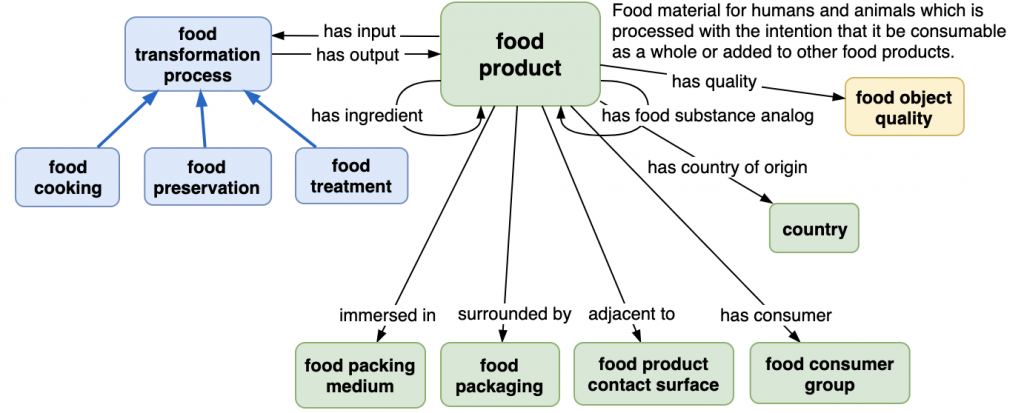A FoodOn facet is a branch of vocabulary devoted to describing some aspect of a food, such as the organism it came from, the part of the organism it mainly consists of, its colour, nutritional components, and for multi-component foods, its ingredient composition, or type of process that has led to its creation. In terms of the Basic Formal Ontology (BFO) each FoodOn facet falls under a BFO ontology class – generally a type of material entity, quality, information about a food product, or process that leads to creation of food. Metaphorically, each facet is like a question in the 21 questions game to guess what a food item is, except the answers are facet terms rather than just yes/no answers.
Facet Index
A list of current facets is displayed below. Facets will be documented on the FoodOn website as they are formalized. First we have FoodOn’s essential primitive facets:
- organism: A reference to a plant, animal, or fungus.
- part of organism: An anatomical reference to a part of an organism, or body product.
In common language a food reference often carries in its minimal semantic the above two facets conjoined, e.g. “apple = a pome fruit from a Malus domestica tree”. FoodOn reflects this semantic in the FoodOn organismal materials spreadsheet under development. In FoodOn product labels we often add some of the implicit facets in parentheses in order to help users distinguish the term they want in ontology lookup services (e.g. an apple will be listed as “apple (whole)” ). Further facets add more information, sometimes implicitly contained in a food term’s context of use (e.g. when one shops for basic grains, they imply the facet attributes of being harvested and packaged).
| Facet | Description |
| harvest state | Whether a food item is harvestable or harvested. |
| degree of plant maturity | A plant lifecycle categorization. |
| food colour facets | Relatted to the colour of plant skin or flesh or animal flesh. |
| food production | Process descriptions of how a food was reared, or how it was prepared in a food facility. |
| climactic food production factor | Describes a seasonal attribute of a food product. |
| regional production | Vocabulary to describe food country and region of origin as well as local distribution. |
| food physical quality | The physical state of the food product (liquid, semiliquid, semisolid, or solid, pieces, etc.). |
| extent of food heat treatment | Broadly characterizes a food product based on the extent of heat applied. |
| food contact materials | Includes packaging, as well as contact surfaces that food encounters during processing. |
| food packing medium integrity | Whether a packing medium has leaked or been removed from a food item. |
| food transformation process | Includes cooking, preservation and treatment processes.Includes cooking, preservation and treatment processes. |
| food chemical component | Provides facets for food nutrients, additives, and other food related compounds. |
| food product hierarchy | A collection of over 9,600 food products organized under facets. |
| agency food product type | Organizations such as EFSA and GS1 have food categorization schemes that offer their own hierarchy and organizing principles which FoodOn will map to in the future. |
Facet usage
Generally there are two ways to use facets in databases or information models.
Bag-of-terms
When describing a food it may suffice to use the “bag of terms” approach. This means associating a food item or class with a list of term ids selected from FoodOn facets. (LanguaL employed this approach in its indexed databases). In tabular data, these ids can all be listed inside a field dedicated to the bag of terms, separated by some delimiter. Alternately a separate column can be set up for each facet, and filled with one or more (delimited) FoodOn ids as appropriate.
Object relations

A more precise model of what a food item is can be constructed in a graph database fashion by linking a food product to particular FoodOn facet terms with a suitable ontology “object property”. In the diagram object properties (which attach between two referenced objects) such as “immersed in”, “surrounded by”, “adjacent to”, “has consumer”, “has food substance analog”, and “has quality” are all used to add information to a food product. Facet documentation above contain the object relations that are appropriate for linking a food item entity class or instance to a facet.